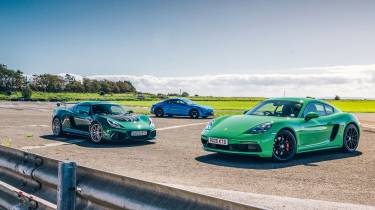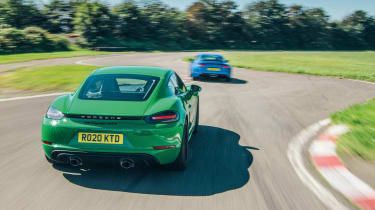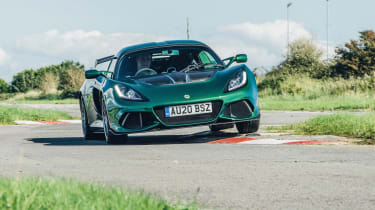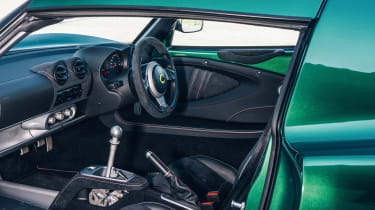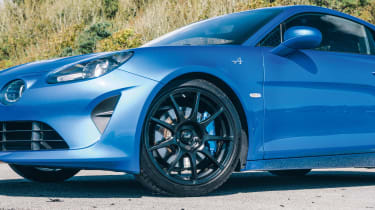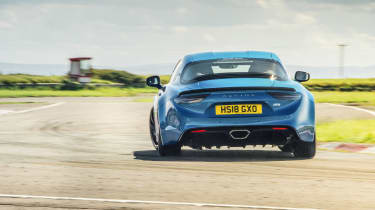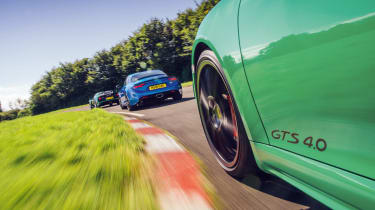Porsche Cayman GTS 4.0 v Life110 Alpine A110 v Lotus Exige Sport 410
Porsche Cayman GTS 4.0, Life110 Alpine A110 and Lotus Exige Sport 410 offer three different interpretations of the sports car theme, but which one really hits the spot? A spirited drive on road and track reveals the answer
I love sports cars. That’s not exactly a surprising revelation, I know, and I’m sure most of you feel the same, but I do – more than any hypercar you care to mention. Sports cars, to my mind, are cars with dimensions, kerb weights and engine outputs ideally suited to enjoyment on a great B-road; cars that are equally at home on a circuit but not overpowered or overbearing; cars that are attainable, even if just vaguely so.
The trouble is, what we loosely term ‘sports cars’ are currently a dying breed, with many major manufacturers simply not making any, and even Lotus about to stop making them for a while, so it’s particularly exciting to get these three together: the all-rounder, the hardcore track machine, and the modified one.
In the blue corner is the Alpine A110, not a standard ‘Pure’, or an S model for that matter, but rather a Life110, the aftermarket tuned version that we first drove in evo 277. If you read that piece you may recall that I fell head-over-heels in love with it, and the opportunity to get it back again for a comparative test was one not to be missed.
Ranged against it are two stalwarts that couldn’t be more different to each other if they tried, despite featuring fundamentally the same mid-engined layout and both having six-cylinder engines. Both have a point to prove: the Porsche once again toting six cylinders from a mainstream mid-engined vehicle from Stuttgart – and ready for revenge on all those taking pot-shots at the Caymans lower down the range. We wondered if it might challenge for overall honours at eCoty last year, but while it made the final, its gradual slump to the penultimate position in the final eight was a shock, one that is in danger of obscuring the fact that it remains a brilliant and hugely desirable car.
Then there’s the Lotus. Keeping up with the firm’s naming policy in recent years hasn’t always been the easiest task, but this Sport 410 model sits between the entry-level Sport 350 and the nutjob Cup 430. Yes, at £79,900, or £91,100 as specced here, its pricing looks uncomfortable next to the other two cars in the test, so we’ll tackle that one head-on right now: despite its best efforts, Lotus wasn’t able to provide us with the Sport 350 version we asked for, a car that costs £59,600 and that feels a much better fit for this test with its slightly less track-focused mantra. For reference, the Cayman GTS is £64,480 (£74,343 as tested) and the Life110 is available from around £54,480 (from a basic ‘Pure’ model starting at £48,990) if you add all the pieces together.
Porsche Cayman GTS 4.0
The destination is Wales, the car, a determinedly retro-inspired green Porsche, and I’m going to take the scenic route. There’s a seemingly bottomless layer of polish to everything that the Cayman does that’s, largely, one of its strongest attributes and, occasionally, its unexpected downfall. It’s an eminently useable machine, with a logical layout, a slick infotainment set-up, comfort and refinement, and controls that exude an oily, finely honed quality, majoring on precision while making little in the way of demands. There’s plenty of luggage space, occupant space, storage space; the gears of the six-speed manual ’box slot home with little more than finger pressure but also retain a tight, mechanical feel that immediately helps you to build a dialogue and subsequent bond with a machine. Yet most of all, initially at least, the Cayman’s biggest draw is its engine, which manages to make 394bhp a constant thrill from the moment you turn the key. It feels like a treat just to have a new internal combustion engine in the early years of the 2020s, but the reach and soundtrack of this 4-litre motor are really something to savour: they are worth the price of admission alone.
Porsche has honed its mid-engined offerings over the past 15 or more years to the point where, dynamically, the Cayman GTS feels as though it has already visited the road you’re about to drive down, with a Porsche chassis engineering team and an accompanying truckload of springs and dampers; it’s as if it knows every inch of it already, with a set-up to suit. You can drive it as fast as you dare, or merely stroke it along at pace; you can be aggressive or super smooth, avoid bumps or ride right over them. Whatever you do, the GTS has the answer for it. Maybe that polish layer is almost worked to an overly smooth finish.
The steering is a near-perfect blend of weight, precision and feedback, the chassis absorbent one moment, suitably taut the next, with brilliant damping and an inherent agility born from having a compact flat engine mounted right down on the floor, nestled up to the back of your seat. There’s no delay with the GTS – you turn, and it turns. In typical Porsche fashion, every major control is perfectly matched to the other ones. What a pity then about the gear ratios – second is so long, it’s all you’ll ever need on a B-road, which often makes the box largely redundant anyway. It’s a small, but nagging flaw, although there is, of course, the PDK option.
Lotus Exige Sport 410
When I arrive at our meeting point, one thing becomes immediately, abundantly clear. Out of the three, the Lotus is by far the most dramatic to look at, and there’s nothing the Porsche’s Python Green paintjob can do to change that. The Exige’s narrow-waisted form and recognisable glasshouse hint strongly at its Elise roots, and while it doesn’t quite pull off the baby endurance racer vibe like the Series 1 K-series-engined Exige did all those years ago, it’s still resolutely extrovert, a cross between a baby supercar and something born to race.
In particular, the jutting front splitter cutting through the air and the high-rise rear wing on its elaborate metal framework supports offer a totally different approach to the smoothed forms of the other two. It’s true, a Sport 350 has a slightly more ‘designed’, low- downforce rear wing, but the effect – at least visually – is largely the same between all the Exige models. Most bystanders don’t even notice the Porsche when the Lotus is in town.
I’ve driven plenty of V6-engined Exiges before, but a re‑aclimatisation is due and I’ll gladly take the opportunity. The ‘410’ relates to the power generated by the venerable, quad-cam, 3.5-litre supercharged Toyota V6, which gets charge-cooling to make the higher output. In a car that weighs around 1141kg (Lotus quotes 1110kg, but this is an unladen figure without fuel, so needs adjusting to make it comparable with the Porsche and Alpine’s DIN weights of 1405kg and 1098kg respectively) that equates to 365bhp per ton, with a 0-62mph time of just 3.4sec. The Sport 410 may possess a hefty price premium in this company, but it’s certainly got the edge on the others in terms of straight-line pace, although it exchanges ultimate top speed for genuine downforce – 115kg of the stuff at its 174mph maximum speed – and hence trails the 182mph Porsche.
Even in those first few moments, the Exige proposition is laid bare – and it couldn’t be any more different to the Porsche’s. You can almost sense the Lotus mocking the German car’s polished manners, excess flab and extensive features. ‘Call yourself a sports car!’ it bellows through that fat centre-exit exhaust pipe, the boisterous bark of the V6 drowning out everything around it. Yes, you must suffer a little to gain access to the cabin – either be naturally athletic or clamber/fall a little inelegantly down into it – but it’s clear that the Lotus will demand more of its driver, and that, indeed, turns out to be the case.
Inside it’s still essentially an Elise. There’s some nice man-made suede elements, some attractively stitched leather, and the exposed gearchange mechanism is a masterstroke, but the tiny, sparse information binnacle, small rotary heater controls, unfathomable single-DIN aftermarket sound system and the aluminium shelf that runs across to the passenger side are all present as usual, along with the Exige’s terrible rear-three-quarter and rear visibility. As ever, I’m gutted to be reminded that I don’t fit properly in these cars – I’m too tall for it, the steering wheel set too low and far away if I sit naturally, or my legs a mess with the wheel more in reach. It’s so infuriating, for if there’s one sports car you really want to feel at one with, it’s the Lotus Elise/Exige family, and I just don’t.
I remember Lotus once telling me that the V6 Exige’s weight and its tyre footprint meant it was at the limit of what was acceptable for a non-power-assisted set-up in terms of steering effort. Low- speed manoeuvring requires genuine bicep power but you do get used to it, adapting to shifting your hands’ position on the wheel in such situations. I’m reminded, too, of the engine’s slightly odd relationship with the throttle, where very small inputs at low speed seem to have little effect, and then a slightly larger one rouses the V6 more than you intended. Couple that with a gearshift intolerant of an imperfect change, plus a light-ish clutch, firm brakes and heavy steering, and the Lotus is a car that takes time to master completely if you want to make smooth, competent progress.
What’s never in question is the Exige’s performance. Its acceleration is delivered in one long stream of power, accompanied by the banshee wail of the engine overlaid with supercharger, an intense bombardment of pace and noise with a linearity that somehow encourages you to keep your foot flat to the floor until the limiter is announcing its stuttering intervention.
Life110 Alpine A110
The comparison with the Life110 is even more interesting. The Alpine weighs pretty much the same as the Lotus, but feels much bigger inside the cabin and much smaller beyond those confines. It’s a real Tardis effect, but with ample elbow room and a calm ride quality it’s actually an effortless everyday companion, no more demanding than the Cayman in most regards, and there’s the convenience of the twin-clutch gearbox, too, which shifts quickly and unobtrusively.
We know that Porsche has dissected an A110 and believes its customers wouldn’t accept Alpine’s standard of build, but given the car’s headline weight, part of me finds that troubling. There’s nothing flimsy or rattly about the Alpine’s interior. You can argue that what lets it down is the naff infotainment system or the lack of maturity in smaller aspects such as the instrument fonts and the tactile workings of the switchgear, but it’s largely subjective, perception stuff.
The Life110 is the work of former head of vehicle dynamics at JLR’s SVO division, David Pook, and is aimed squarely at tackling the criticisms we’ve always had of the little French sports car: namely its slightly unnerving remoteness on corner entry and a sometimes wayward tail that can easily catch out the unwary. There’s so much to admire dynamically about the A110, but we’ve always felt there’s been room for improvement.
Pook highlights the standard car’s toe-out setting at the front axle and toe-in at the rear, the former causing the car to wander at speed and the latter a reluctance to turn in. So far, the S models he’s measured have all had even more toe at the rear (although the factory settings are the same). He’s bought some S anti-roll bars (which he describes as ‘flipping enormous’) and tried them on his car, but he dislikes the lateral kickback over poor surfaces and the understeer they bring, both of which we found with the S on eCoty, along with a corruption to the car’s steering. Instead, the Life package consists of a radical rethink of the suspension geo; stiffer springs that lower the car; the wheels and rear spoiler from the Alpine Cup racing car; an engine remap via DMS Automotive that yields 296bhp and 280lb ft of torque; Pook’s own design of gearshift paddles, and uprated front brake pads (with similarly uprated rears on the way).
The result, as we’ve said before, is extraordinary. You can have so much faith now in what the front end is going to do, and the rear of the car feels much more stable during more extreme manoeuvres. Confidence is the key with the Life110 mods, for you feel the Alpine is completely within your command at all times, without the effort and harshness of the Lotus. The front end now positively dives for the apex, and with body roll reduced that occasional sense of roll oversteer with, say, a sudden lift of the throttle mid-corner, is eradicated. There’s a slight detriment to the Alpine’s fabulously supple ride, but only really at low speed: the vast bulk of the car’s inherent, loose-limbed character remains, enabled by its ultra-low kerb weight, and it’s a joy.
We’ve called in at the tiny Llandow circuit for a quick blast. It’s hardly the Nürburgring, but it will allow us to safely – well, sort of – explore the outer reaches of our trio’s respective handling envelopes. I start off in the Porsche, for it feels like a predictable place to begin, in an entirely positive way. Wow, does that flat-six sing: the ratios still feel long, but it’s less of an issue on a circuit than on the road. The Cayman encourages you, communicates with you, and never loses its composure. The brakes are resilient, and when you breach its limits there’s a clear and logical pattern to what it does. That it happens rather quickly at times is to be expected of a mid-engined car, but as long as you’re ready for it, then even on the fast, off-camber right-hander at the back of the circuit the car can be turned in on the brakes, at the top of third gear, allowed to set an attitude, and then powered through with a quarter of a turn of opposite lock. It can overwhelm the rears in the slower stuff, but it requires very deliberate provocation in the dry, such is the purchase it finds on the road’s surface.
The Lotus is a complete contrast. It’s much more focused, not just in its demeanour but also in how it demands you drive it. While the steering loses weight as the speed rises, it puts it all back on again when you want to turn, particularly in the high-speed corners where you really need to hang onto the car with brute force. Couple that with a definite feeling that the engine’s mass is located towards the rear of the car, and for me there’s a nagging sense that if it lets go at high speed, I’m unlikely to catch it. It feels surprisingly stiff, too, particularly across the front axle, and its Michelin Cup 2s want to dig in or slightly understeer in the slower stuff rather than let you indulge in some mild oversteer, while its gearshift is easy to baulk if you rush the change and heel-and-toe downshifts feel awkward. If the Cayman is the sort of car that you can just exit the pitlane and have a ball in, the Lotus is a car that needs proper learning... and I’ll freely admit today’s session is not enough. However, both its Nitron dampers and Eibach anti-roll bars are adjustable, providing the Exige driver the opportunity to set-up as desired.
The Life110 is quite different. The remapped engine now has the top-end power to feel at home on a circuit, but it’s the much keener body control that transforms the experience and reminds me of a track test in the Cup race car. There’s a ‘bus stop’ style chicane by the control tower and the way the Alpine rotates into the corner, then snaps the other way without inertia, lining up perfectly for the exit curve, is exquisite. It’ll also drift controllably around the next right, and even when the tail breaks away on the higher speed back section through a little too much exuberance with corner speed, it’s ridiculously easy to gather together.
Once you’ve felt that sort of hyper-agility, it’s addictive. I drive the Porsche again, and without the direct focus of its GT4 twin’s reactions the GTS can just feel a little soft, more conciously affected by the inertia of its mass. The GTS is a brilliant car, and it takes something really special to cast it in that light, but it’s an inescapable conclusion in this company.
The Lotus is the first to fall in my book. It’s an outlier here, existing as ever on the fringes of the sports car world and feeling much more one-dimensional than the others. You’ve probably read that before, and there’s no reason why it should change now: some will adore it for what it is. And yet I didn’t enjoy it as much as I thought I would in a track environment, and while I love it for its drama and what it represents – and the thrill it provides on the right road – it’s too compromised a lot of the time, while its powertrain is undeniably effective but somehow lacks a cohesive class and depth. It feels heresy to say it, but in spite of loving how it looks, its not a car I warm to when driving.
Splitting the other two is a much, much harder business. The crux is the Porsche’s engine and gearbox, which are, ratios aside, completely sublime. Yes, it’s also a complete package, and it has that badge, but as a driving enthusiast it’s the powertrain that makes it so hard to overlook. Yet such is the thrill of the Life110 that I reckon I could make that compromise – just. I’d take the little blue car for one reason above all others: however great its dynamics, the GTS can never fully conceal its 300kg penalty over the Alpine, and that means it needs to be driven harder, further and on indulgent roads to fully reveal its talents. It needs those loads placed upon it to come alive, but the magic of the A110, fully exploited in Life110 form at last, is that any and every journey can give you those thrills, without any obvious compromises. That’s the beauty of a true sports car, and that’s why in my opinion blue vanquishes green.
Specs
| Lotus Exige Sport 410 | Life110 Alpine A110 | Porsche Cayman GTS 4.0 | |
| Engine | V6, 3456cc, supercharged | In-line 4-cyl, 1798cc, turbo | Flat-6-cyl, 3995cc |
| Power | 410bhp @ 7000rpm | 296bhp @ n/a rpm | 394bhp @ 7000rpm |
| Torque | 310lb ft @ 3500rpm | 280lb ft @ n/a rpm | 310lb ft @ 5000rpm |
| Weight | 1141kg | 1098kg | 1405kg |
| Power-to-weight | 365bhp/ton | 274bhp/ton | 285bhp/ton |
| 0-62mph | 3.4sec | c4.4sec | 4.5sec |
| Top speed | 174mph | c160mph | 182mph |
| Basic price | £79,900 | £54,480 | £64,480 |
This story was first featured in issue 283.

